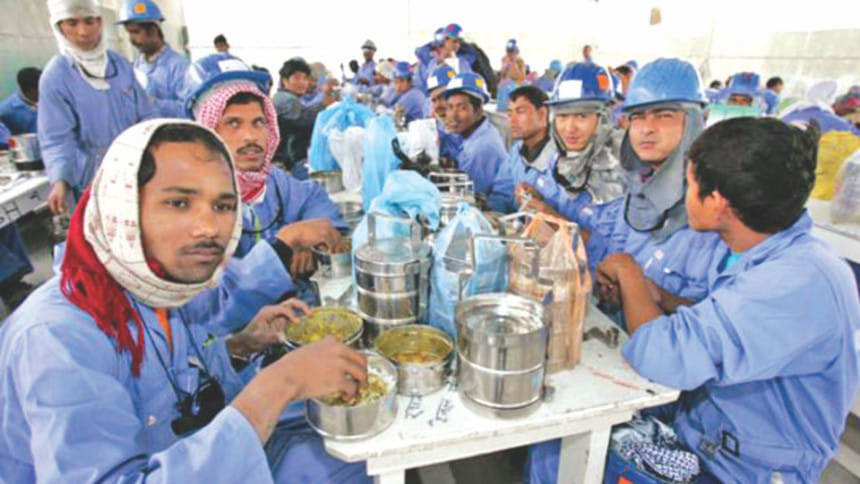The future of remittance flows

While waiting for my connecting flight to Dhaka at Dubai's airport lounge, I came across throngs of fellow Bangladeshi nationals waiting to fly back home. Most of them eke out a hard-earned living in the Middle East while facing demanding working hours, harsh living conditions and fears of deportation to support their families back home. Additionally, the workers are treated as inferiors while adjusting to life on foreign soil. Yet, to add to their worries, they will likely face difficulties in securing jobs in the Middle East in the coming years.
With more than 8 million migrant workers abroad, Bangladesh earned about $15.31 billion in foreign remittances—about 10 percent of the country's GDP—in the recently concluded fiscal year. Moreover, 60 percent of all inflows to Bangladesh come from the Middle East. The Gulf Cooperation Council (GCC) countries—particularly Saudi Arabia and UAE—are the biggest employers of Bangladesh's largely unskilled migrant labour force; currently, more than 80 percent of all private sector jobs in the GCC are held by low-skilled foreigners. However, Gulf nations are enforcing nationalisation policies within the private sector to tackle rising unemployment among GCC nationals.
Saudi Arabia, for instance, is considered the experimental hub for nationalisation policies among Gulf nations. According to 2014 estimates—with roughly 400,000 new entrants to the labour force annually— it faces an unemployment rate of 11.74 percent and must create 1.1 million jobs for Saudis to successfully tackle the issue. Currently, the public sector is the biggest employer of Saudi nationals while foreign workers account for 85 percent of all Saudi private sector employees. Yet, the IMF states that public sector jobs are growing at a slower pace than those in the private sector. Consequently, at a recent summit held at the UN New York headquarters, the Kingdom's Ministry of Labour representatives emphasised on labour nationalisation policies; they highlighted the need to cut down their reliance on foreign workers to shift more Saudis into the private sector.
While Saudi nationalisation policies have been in place since the 1990s, the government has redoubled its efforts to implement labour market reforms through the ambitious Nitaqat quota system. Introduced in 2011, it aims to recruit more Saudis instead of migrant workers in the private sector; the "Nitaqat" (bands) classify firms into four levels of compliance with various combinations of penalties and incentives that chiefly restrict the firms' ability to acquire new work visas. Alongside such policies, the government now carries out a "correction" campaign or mass deportation programmes for undocumented workers. In late 2013, nearly 2 million expatriates were deported from Saudi Arabia. Currently, Saudi Arabia only permits migrants with machine-readable passports (MRP) to work in the country; according to Asia News Network, nearly 2.2 million Bangladeshi workers risk losing their jobs and face deportation if they don't obtain MRPs by November 24, 2015. Sadly, mission officials in the capital, Riyadh, have stated that it will be a monumental task to issue 0.24 million MRPs per month to cover all Bangladeshi workers.
Interestingly, experts opine that the Saudisation scheme will not affect migrant-sending countries in the short run. On one hand, the Nitaqat system has problematic incentives that focus on employing Saudis in numbers rather than based on their capabilities. On the other hand, according to the Saudi Gazette, the government is reconsidering implementing the system in specific sectors as it fails to attract Saudi citizens. Additionally, after Saudi Arabia lifted its 7-year ban on recruiting Bangladeshi migrant workers in February 2015, prospective migrants became hopeful about carving out a future in the Gulf state. Yet, considering Saudi Arabia's long-term efforts to curtail its migrant workforce, sending workers en masse to the Saudi kingdom is an unwise decision.
Given how remittances play a crucial role in the Bangladeshi economy, seeking new markets for manpower exports is a viable option for the Bangladeshi government. Many economies, however, require skilled foreign workers. According to a recent article published in the Financial Express, Bangladesh's exports of skilled manpower has declined from 45 percent in 2005 to 36 percent in 2014; the country is lagging behind competing nations in terms of receiving increased remittances. Hence, it is critical to equip Bangladesh's largely unskilled migrant workforce with the technical education and training demanded in prospective manpower markets. As this measure entails great foresight and careful planning, the Bangladeshi government can approach economies such as Japan where the East Asian government has an excellent track record in investing in human capital through its technical and vocational education sector. Simultaneously, Bangladesh can set up a data system that assesses the skills acquired by repatriated workers to absorb them into the local job market or arrange for them to acquire work visas abroad. In any case, Bangladesh needs to plan for a well-defined strategy to sustain remittance inflows in the long run.
The writer studied Economics at Mount Holyoke College, USA.

 For all latest news, follow The Daily Star's Google News channel.
For all latest news, follow The Daily Star's Google News channel. 



Comments